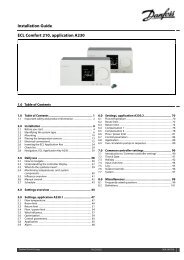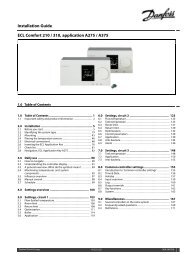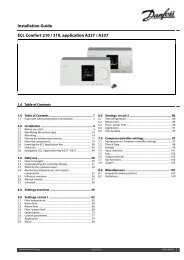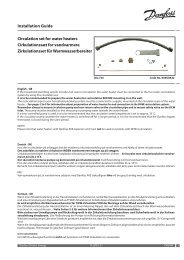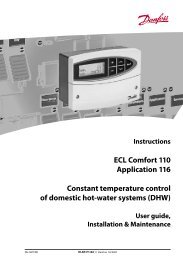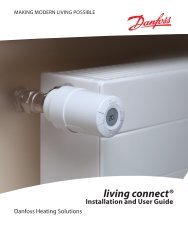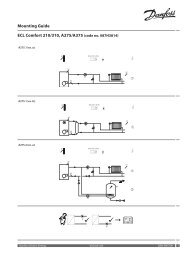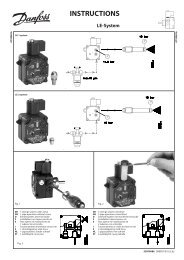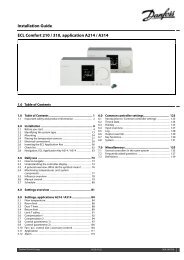ECL Comfort 210/310, A275/A375 Installation Guide - Danfoss ...
ECL Comfort 210/310, A275/A375 Installation Guide - Danfoss ...
ECL Comfort 210/310, A275/A375 Installation Guide - Danfoss ...
Create successful ePaper yourself
Turn your PDF publications into a flip-book with our unique Google optimized e-Paper software.
<strong>Installation</strong> <strong>Guide</strong> <strong>ECL</strong> <strong>Comfort</strong> <strong>210</strong> / <strong>310</strong>, application <strong>A275</strong> / <strong>A375</strong><br />
6.3 Room limit<br />
This section is only relevant if you have installed a room<br />
temperature sensor or a Remote Control Unit.<br />
The controller adjusts the desired flow temperature to compensate<br />
for the difference between the desired and the actual room<br />
temperature.<br />
If the room temperature is higher than the desired value, the<br />
desired flow temperature can be reduced.<br />
The 'Infl. -max.' (Influence, max. room temp.) determines how<br />
much the desired flow temperature should be reduced.<br />
Use this influence type to avoid a too high room temperature. The<br />
controller will allow for free heat gains, i.e. solar radiation or heat<br />
from a fire place etc.<br />
If the room temperature is lower than the desired value, the desired<br />
flow temperature can be increased.<br />
The 'Infl. -min.' (Influence, min. room temperature) determines<br />
how much the desired flow temperature should be increased.<br />
Use this influence type to avoid a too low room temperature. This<br />
could e.g. be caused by windy surroundings.<br />
A typical setting will be -4.0 for 'Infl. -max.' and 4.0 for 'Infl. -min.'<br />
Infl. - max. (room temp. limitation, max.) 12182<br />
Circuit Setting range Factory setting<br />
2 -9.9 ... 0.0 -4.0<br />
Determines how much the desired flow temperature will be influenced<br />
(decreased) if the actual room temperature is higher than the desired room<br />
temperature (P control).<br />
-9.9: The room temperature has a big influence.<br />
0.0: The room temperature has no influence.<br />
Influence<br />
‘Infl. - min.’ (min. limitation)<br />
Desired room temperature<br />
Actual room temperature<br />
‘Infl. - max.’ (max. limitation)<br />
The ‘Infl. - max.’ and 'Infl. - min.' determine how much the room<br />
temperature should influence the desired flow temperature.<br />
If the ‘Infl.’ factor is too high and / or the ‘Adapt. time’ too low, there is<br />
a risk of unstable control.<br />
Example 1:<br />
The actual room temperature is 2 degrees too high.<br />
The ‘Infl. - max.’ is set to -4.0.<br />
The ‘Infl. - min.’ is set to 0.0.<br />
The slope is 1.8 (see 'Heat curve' in 'Flow temperature').<br />
Result:<br />
The desired flow temperature is changed by (2 x -4.0 x 1.8)<br />
–14.4 degrees.<br />
Example 2:<br />
The actual room temperature is 3 degrees too low.<br />
The ‘Infl. - max.’ is set to -4.0.<br />
The ‘Infl. - min.’ is set to 2.0.<br />
The slope is 1.8 (see 'Heat curve' in 'Flow temperature').<br />
Result:<br />
The desired flow temperature is changed by (3 x 2.0 x 1.8)<br />
10.8 degrees.<br />
<strong>Danfoss</strong> District Energy VI.GU.L1.02 DEN-SMT/DK 127



